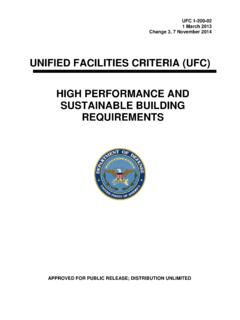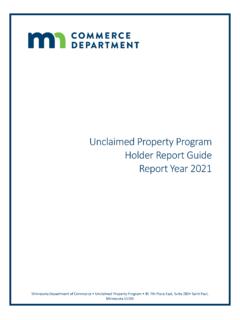Transcription of Guidance - Under Secretary of Defense for Acquisition and ...
1 Guidance on Using Incentive and Other Contract Types March 2016 2 Table of Contents Page 4 - 5 Background Contract Type as an Element of Overall Compensation Contract Performance Risk Page 5 - 7 Market Risk Factors in Selection of Contract Type Uncertainties of Performance Page 7-8 Contract Types Difference Between Fixed-Price and Cost-Reimbursement Contracts Page 9-12 Cost-Reimbursement Type Contracts Cost Contracts Cost-Sharing Contracts Cost-Plus-Fixed-Fee-Contracts Page 12-16 Fixed-Price Type Contracts Firm-Fixed Price Contracts Increased Profit Percentage Realized as an Incentive in FFP Contracts Fixed-Price Contracts with Economic Price Adjustment Fixed-Price Contracts with Prospective Price Redetermination Fixed-Ceiling-Price Contracts with Retroactive Price Redetermination Firm-Fixed-Price Level-of-Effort Contracts Page 16-19 Incentive Contracts Importance of Incentive Contracts Basic Principles of Incentive Contracts Competing Incentives All or Nothing Cost Incentives 3 Page 19-23 Types of Incentive Contracts Award-Fee Contracts Fixed-Price Contracts with Award-Fees Cost-Plus-Award-Fee Contracts Page 23-24 Predetermined
2 Formula-type Incentive Contracts Cost-Plus-Incentive-Fee Contracts Page 24-32 Fixed-Price Incentive Contracts Fixed-Price Incentive (Firm Target) FPI(F)Contracts Achieving a Reasonably Challenging but Achievable Cost How to Determine Profit Amount and Underrun Share How to Determine Ceiling Price and Overrun Share Point of Total Assumption Cost Incentive Geometry Page 33-37 Example of the Reasonably Challenging but Achievable Approach Revised Government Offer Based on New Information Government Position Based on Negotiation Concession Understanding the Strategy Applying the Strategy Alternate Approach Page 37-39 Fixed-Price Incentive (Successive Targets) Contracts Situation for Use of FPI(S)
3 Contracts Appropriateness of FFP or FPI Contracts for Development Effort Page 40 Time and Materials / Labor Hour Contracts Summary Page 41 Contract Types Matrix 4 Background This Guidance was developed as an element of the Under Secretary of Defense , Acquisition , Technology and Logistics (USD (AT&L)) Better Buying Power (BBP) Achieving Dominant Capabilities through Technical Excellence and Innovation initiative. The analysis behind the 2014 Annual Report on the Performance of the Defense Acquisition System, published by the USD (AT&L)) on June 13, 2014, demonstrated that the use of cost-plus-incentive-fee (CPIF) and fixed-price-incentive Firm Target (FPI(F)) contracts was highly correlated with programs that achieved better cost and schedule performance outcomes.
4 Therefore, our preference is to employ these contract types when they are appropriate. Contract Type as an Element of Overall Contractor Compensation Contract type is just one element of the overall contractor compensation arrangement, which includes contract financing, profit or fee, incentives, and contract terms and conditions. Selection of the appropriate contract type depends on a multitude of factors, including the Acquisition situation, and is a matter for negotiation. Since the contract type and the negotiated contract pricing are interrelated, they must be considered together. The overall compensation arrangement considers contract type, pricing, and financing together.
5 Preferably, contracts are forward priced (as opposed to authorizing contractors to proceed Under an undefinitized contract action or letter contract). Forward pricing requires the contracting parties to make assumptions about future changes in the marketplace. The chosen contract type and negotiated pricing should: Result in a reasonable degree and balance of risk between the Government and the contractor; and Provide the contractor with the greatest incentive for efficient and economical performance. Generally, contract types vary according to: The degree and timing of the responsibility/risk assumed by the contractor for the costs of performance; and The amount and nature of the profit incentive offered to the contractor for achieving or exceeding specified standards or goals.
6 As a minimum, the appraisal of cost risk should consider two areas of particular concern--contract performance risk and market risk. Contract Performance Risk Risk associated with the work to be performed is the most important factor when selecting contract type. Most contract cost risk is related to contract requirements and the uncertainty surrounding contract performance. Areas to consider should include: 5 Stability and clarity of the contract specifications or statement of work; Type and complexity of the item or service being purchased; Uncertainties impacting performance, such as maturity of technology being developed, implemented or utilized; Availability of historical cost and pricing data; Prior experience in providing required supplies or services; Contractor technical capability and financial responsibility; and Extent and nature of proposed subcontracting.
7 Performance risk should be reduced from a high to a relatively low level as the requirement progresses from vague to well-defined, and uncertainty regarding feasibility and cost/time to perform decreases. For example, research and development contracts generally have a rather high degree of performance risk. This is due to the fact of having lesser-defined requirements that arise from the necessity to deal beyond, or at least very near, the upper limits of current technology ( , "the state of the art"). Whereas, follow-on production contracts generally have a relatively low performance risk. In a production contract, requirements are well known, there is a cost history to draw on, and contractors have experience producing the product.
8 As performance risk changes, so should contract type. Market Risk Changes in the marketplace will also affect contract costs. Consider: A volatile market will increase the cost risk involved in contract pricing, particularly when the contract period will extend several years ( , potential fluctuations in material and labor cost and potential material shortages in the future); In cases where costs subject to potentially large market fluctuations are significant, contract period risk becomes an important consideration in selection of contract type; and Fixed-price contracts with economic price adjustment, for example, are designed specifically to reduce this risk for contractors.
9 Factors in Selection of Contract Type The Federal Acquisition Regulation (FAR), Subpart , includes the following factors to consider in selecting contract type: Type and complexity of the requirement; Urgency of the requirement; Period of performance or length of production run; Contractor s technical capability and financial responsibility; Concurrent contracts; 6 Extent and nature of proposed subcontracting; Acquisition history; Degree to which price competition results in realistic pricing; Degree to which price analysis can provide a reasonable pricing standard; and Cost analysis including assessment of cost impact of uncertainties and reasonable allocation of cost responsibility to the contractor.
10 Uncertainties in Performance One Government objective is to provide the contractor with whatever degree of cost responsibility and incentive that is consistent with the circumstances. This necessitates an analysis of the procurement situation and an assessment of the uncertainties of contract performance and their possible impact on cost. The uncertainties involved in performance and their possible impact upon costs must be identified and evaluated so that a contract type can be negotiated that places a reasonable degree of cost responsibility upon the contractor. Depending on the procurement situation and skills of the negotiators, there can be uncertainties with regard to the estimating assumptions.

















